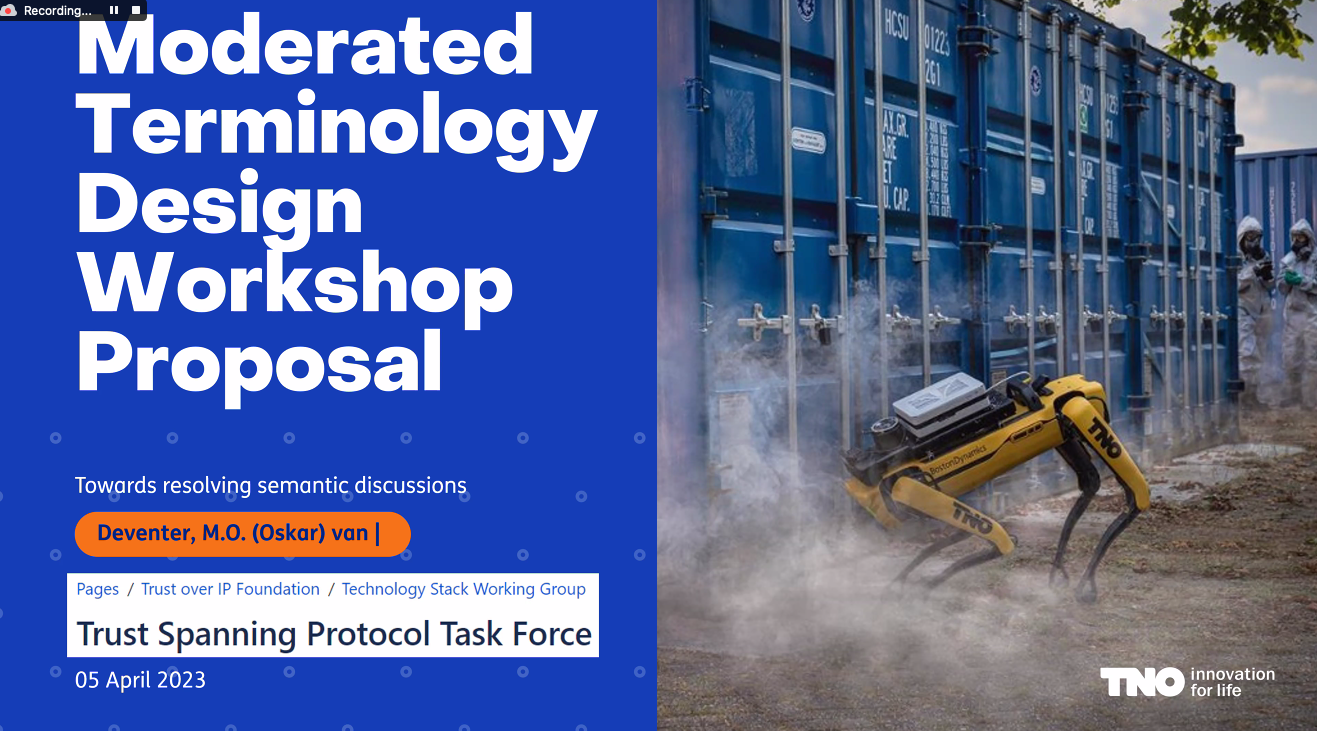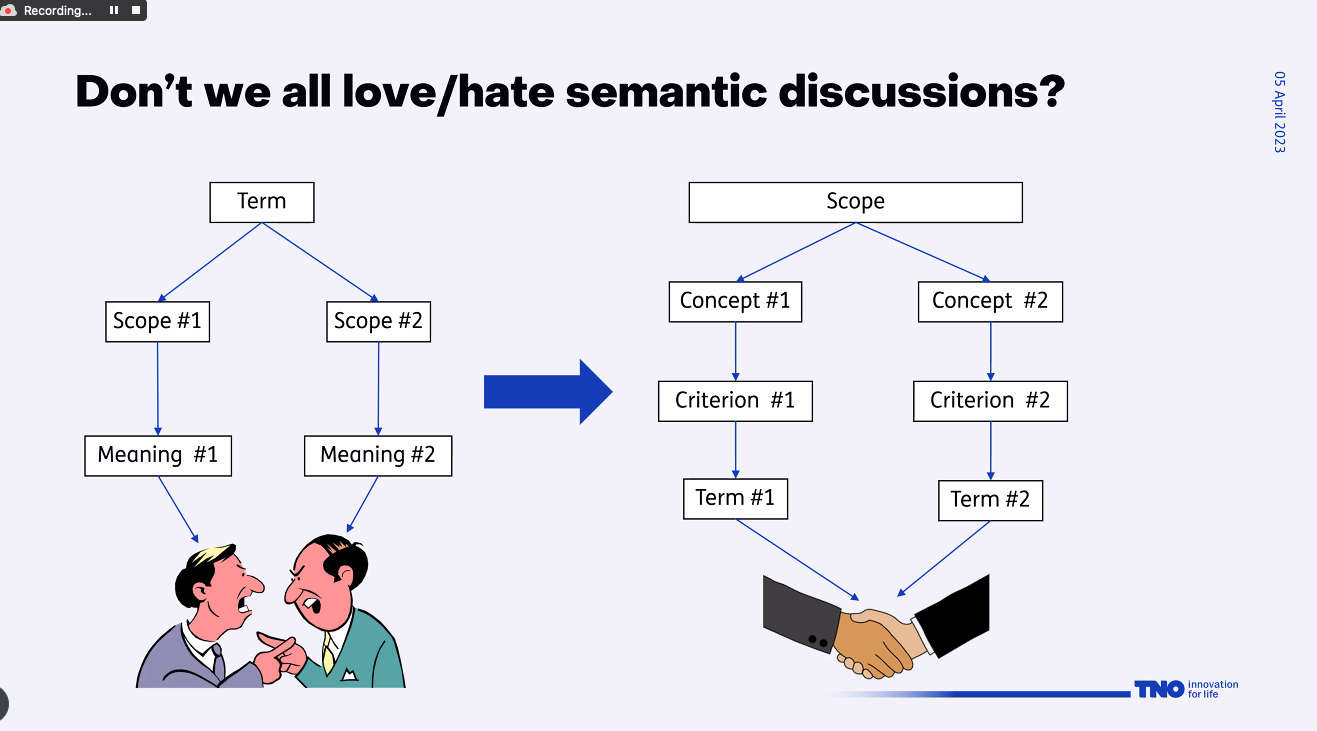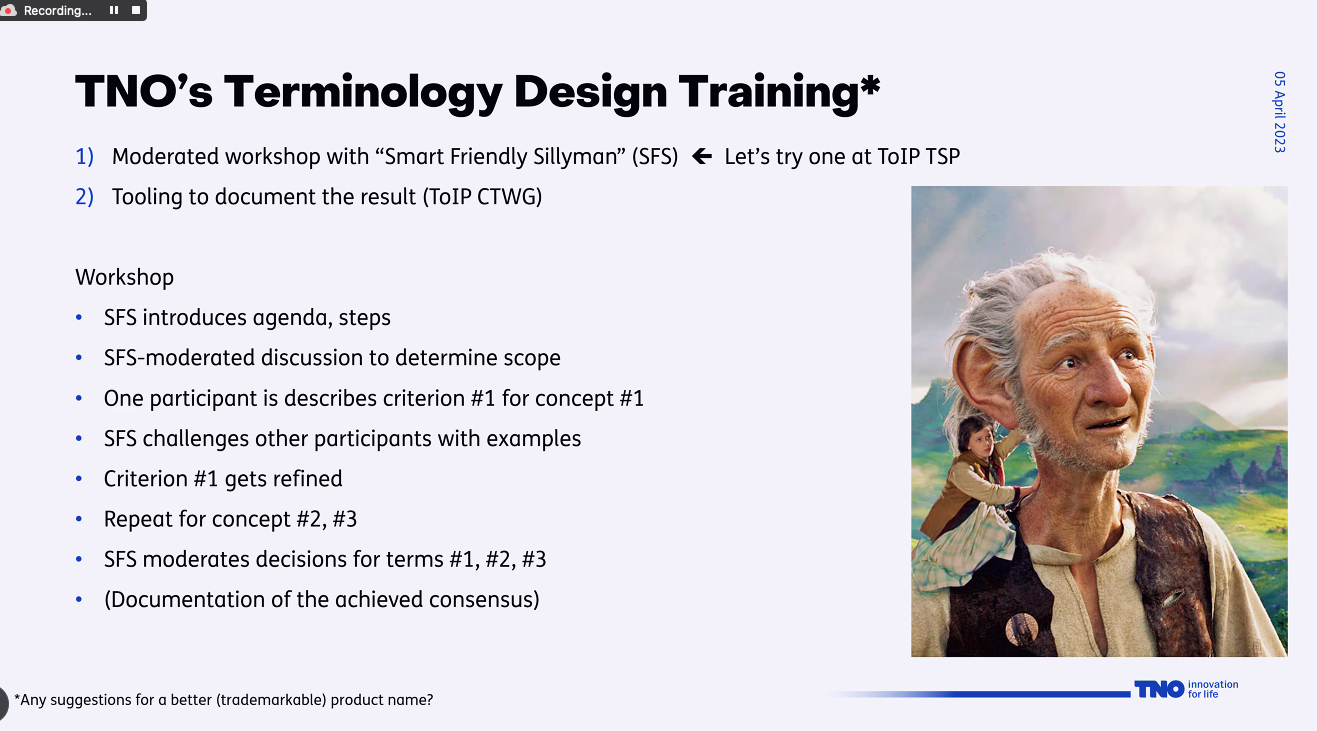Meeting Date & Time
This Task Force meets three out of every four Wednesdays (the fourth Wednesday is the Technology Stack WG plenary meeting). There are two meetings each Wednesday to serve different time zones:
- NA/EU meeting: 08:00-09:00 PT / 15:00-16:00 UTC
- APAC meeting: 18:00-19:00 PT / 01:00-02:00 UTC
See the Calendar of ToIP Meetings for exact meeting dates, times and Zoom links.
Zoom Meeting Recordings
- NA/EU Meeting: https://zoom.us/rec/share/wNDi4k5NbhANZ2sYzxbd3ozHTqy_biWvQmZIZAYlxYL5u0qtibfDNYcSi7cjXnE4.gL0AvCJiyjGjq10s
- APAC Meeting: https://zoom.us/rec/share/VM1mNH05rIMYk81HnTta3jX1NexTk3MtkKPUQuPUOV8R-5yGQlGqhq4XT_qRvbqj.lhsP45PZJmtLjLZT
Attendees
NA/EU:
- Drummond Reed
- Daniel Hardman
- Wenjing Chu
- Samuel Smith
- Darrell O'Donnell
- Alex Andrei
- Antti Kettunen
- Christine Martin
- Daniel Bachenheimer
- Judith Fleenor
- Lance Byrd
- Mathieu Glaude
- Michael Herman
- Neil Thomson
- Oskar van Deventer
- Rodolfo Miranda
- Sam Curren
- Savita Farooqui
- Scott Whitmire
- Steve McCown
- Steven Mugisha Mizero
- P A Subrahmanyam
- Subhasis Ojha
- Willem de Kok
APAC:
- Drummond Reed
- Jo Spencer
- Jo Spencer
- Steven Mugisha Mizero
- Dima Postnikov
Agenda Items and Notes (including all relevant links)
| Time | Agenda Item | Lead | Notes |
| 3 min |
| Leads |
|
| 2 min | Review of previous action items | Leads |
|
| 20 mins | Timeline Considerations for the TSPTF Consolidation Stage | Sam Curren | Sam presented a short set of slides raising key questions about how long we want the TSP spec process to take. Sam's TL:DR is "Let's pay attention to the timeline effects of our choices" as we go through the consolidation phase. Daniel Hardman: Would like to get a sense of the TF's sense of this topic. There's no really good way to measure, but do you have any suggestions about how? Drummond Reed: suggested using the polling feature of Github Discussions. Darrell O'Donnell: It's very important what those choices are in the poll. It's not "either/or" in terms of "go fast or get everything right". Oskar van Deventer: "As for timelines: who are the prospect implementors and users? I'd like to see TSP used by the large European identity (eIDAS, EUDI wallet, LSP) programs." In the European Digital Identity Wallets Architecture Reference Framework (ARF), there is no good references to ToIP. Sam Curren: It can be challenging to figure out how to accurately predict timelines. Antti Kettunen: Regarding eIDAS 2.0 and the Large Scale Pilots, there is some work going on to map the ToIP model to the EUDIW ARF. The EU is definitely very interested in the ToIP model. The LSPs can also try to align with the ToIP model, and then align with a migration path. Neil Thomson: Assuming incremental develop with useful releases at a useful cadence. there are some key decisions, one of which is: To get a "right answer" long term, realistically, breaking changes need to be acceptable. The other is to spend time to build bridging solutions for 'existing' solutions to new versions. Savita Farooqui: I agree with Neil, that approaching it in an agile manner is useful - with urgency, understanding that refactoring may be needed. We can learn from/about the other efforts to seek alignment, but independent approach is also useful - if we bring a different perspective. ACTION: Sam Curren to create a Github Discussion to figure out the wording of the choices in the poll, and then to hold the poll. APAC: Jo Spencer: There is a dychotomy between those who have solutions to sell and those who have requirements to meet. So there is a natural tension. So what are we trying to achieve with the TSP in terms of what we hope will happen with other existing protocols, i.e., think about what adoption paths really look like. For example, if we were drawing a roadmap, what we're after is establishing a common path that implementers can align to, so each of them can then map out their own path. Demand should drive the adoption and migration to the TSP target state. That's why projects like the EUDIW project are the kinds of projects we need to effect. Drummond Reed pointed out that this was what Wenjing Chu highlighted in his last presentation (March 22). He made the comparison to the adoption of TCP/IP against some other solutions that had a much bigger headstart. Daniel Bachenheimer: the EUDIW doesn't really talk about "trust" outside of trust lists. But interoperability between those trust communities (e.g., member states). So work we are doing here (and in the Trust Registry TF) is highly relevant. Jo Spencer Yes, the EUDIW needs a solution for what they need right now, which is identification of citizens. Daniel Bachenheimer agreed that they are focusing on mDOCs and OIDC4VC because that's the most mature solution that will meet their immediate requirements. Dima Postnikov The good news is that EU is not re-creating standards, they are looking at available options now. Plus governments have to make sure it works with their current systems and vendors. And governments do the voting. Jo Spencer If we don't agree on the important things that need to be included for this protocol, then we miss the opportunity to move the market in the right direction. "We don't start with a greenfield — it's actually very muddy." Dima Postnikov If there is any opportunity to influence them, it is best to get them focused on principles and requirements. |
| 10 mins | Moderated Terminology Design Workshop Proposal | Oskar van Deventer | If Oskar is able to attend, he will present a proposal for his organization, TNO, to moderate a terminology design session. (This is very timely given our work right now on the ToIP Glossary Workspace.) See also this wonderful new draft paper from Rieks Joosten on Conceptual Models (aka mental models). Oscar presented three slides (screenshots #1, #2, #3 below) as part of an offer for TNO to moderate a terminology design workshop for the ToIP Foundation — and specifically the TSWG and the ToIP stack. This workshop would be moderated by a professional "Smart Friendly Sillyman" (SFS) trained in this methodology. He will start out explaining the workshop, then one concept will be discussed, to see if the the group can agree on the criteria that actually applies to distinguish that concept. The SFS will constantly focus on misunderstandings. The second step is, after the workshop, there will be some tooling for documenting the conclusions coming out of the workshop. Oskar is offering an initial one-hour workshop. His question is: are we as a group sufficiently patient enough to do this? Judith Fleenor: Could it be for the whole of ToIP? Oskar van Deventer: It would be best to keep it focused on a tight subject. So it would be best for the first trial workshop to be for the TSP. Then he would offer a second workshop for a larger ToIP audience. Sam Curren: This could actually speed up the process. Oskar van Deventer: May 3rd at our normal time would be the best time. Drummond Reed: Would it help to have a Github discussion thread to prep? Oskar van Deventer: Yes. ACTION: Oskar van Deventer to create a Github discussion thread to prep for a Moderated Terminology Design Workshop at our NA/EU meeting on 03 May 2023. APAC: There was overwhelming support for this workshop — and a second one for a larger ToIP audience. There was also agreement that the time investment will pay off because agreement on terms will help us go much faster. |
| 20 mins | Preparing for our first TSP Workshop | Leads | Our first TSP Workshop — a two-hour deep-dive — will be held this coming Thursday April 6 at 1:00-3:00PM PDT / 20:00-22:00 UTC / 22:00-24:00 CEST / 06:00-08:00 AEST. The Zoom link is now on the ToIP Calendar. Wenjing Chu has agreed to start the meeting by giving a recap of the ToIP Technology Architecture Specification V1.0, especially the requirements for ToIP Layer 2. This should take approximately the first 30 mins. We then need to decide the best topic(s) to discuss in the remaining 90 minutes. Also, we have also scheduled a second TSP Workshop for the same time on Thursday April 13th provided we are ready for it. Daniel Hardman: The biggest area where we need to hammer out alignment is whether we need to be descriptive or prescriptive. Does the TSP need to say what must be done to achieve certain levels of trust, or do we need to provide a mechanism for agreeing on trust and let the participants decide the level of trust they are trying to achieve. This is fundamental to many of the architectural decisions we will need to make in the consolidation stage. He used the example of discussions about having a summit on climate change: what are the goals. Daniel volunteered to frame up this question at the start of the discussion period in tomorrow's TSP Workshop. Neil Thomson: It needs to be requirements-driven. A lot of the trust tasks at Layer 3 are asking specific questions and requesting certain type of proofs to proceed. APAC: Jo Spencer Accreditation is a factor: what you create controls how it is used. Daniel Bachenheimer gave the example of ID2020 creating a set of requirements that prospective candidates can then get certified for interoperability profiles. Jo Spencer There are also different levels of interoperability — technical, governance, UI, etc. |
| 5 min | Reminder about inputs for our 3rd generation ToIP stack diagram | Drummond Reed | See this Google Slides deck where we are accepting proposals. Note that several very new ideas have already been submitted proposing some very interesting new perspectives on how to communicate the key ideas of the ToIP stack, including the relationship of the Governance Stack to the Technology Stack. ACTION: ALL TSPTF MEMBERS to review the Google Slides deck where we are accepting proposals for the 3rd generation ToIP stack diagram and submit any ideas, suggestions, or comments you have. |
| Leads | Reminder: We will be meeting again next week and then taking a week off for Internet Identity Workshop (April 18-20 in Mountain View). |
Screenshots/Diagrams (numbered for reference in notes above)
#1
#2
#3
Decisions
- None
Action Items
- ACTION: Sam Curren to: 1) Create a Github Discussion to figure out the wording of the choices in a poll about TSPTF member preferences for how long they believe is optimal for the TSP spec process to take (see Sam's slides on the topic), and once there is rough consensus on the choices, 2) run the poll using the Github Discussions polling feature.
- ACTION: Oskar van Deventer to create a Github discussion thread to prep for a TNO-Moderated Terminology Design Workshop at our NA/EU meeting on 03 May 2023.
- ACTION: ALL TSPTF MEMBERS to review the Google Slides deck where we are accepting proposals for the 3rd generation ToIP stack diagram and submit any ideas, suggestions, or comments you have.


